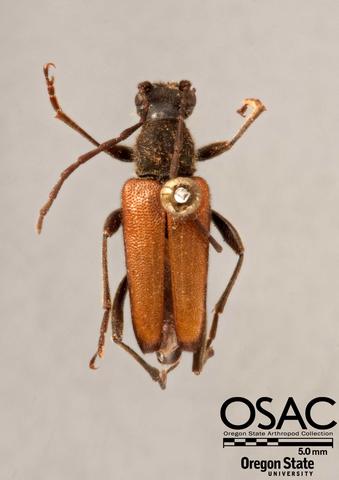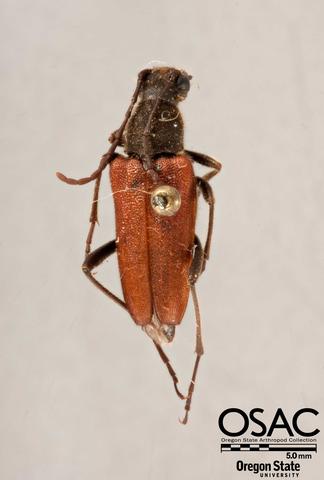You are here
Lepturinae
Anastrangalia Casey, 1924
Nomenclature
-
Subfamily: LepturinaeTribe: Lepturini
SUMMARY
Two Anastrangalia species can be found in the Pacific Northwest (17 spp. and subspp. worldwide).
Anastrangalia Casey, 1924:280
laetifica (LeConte, 1859:89)
lugens LeConte, 1859:89
sanguinea (LeConte, 1859:89)
boulderensis Casey, 1913:252
apicata Casey, 1924:280
Diagnosis. "This genus is characterized by the subcylindrical, weakly convex, and shallowly impressed pronotum. The very short face, the subparallel tempora, and the weakly subserrate antennae are also distinctive." (Linsley and Chemsak, 1976, p. 144)
Key to PNW species
(1.) males with basal punctures of the elytra larger than those of the pronotum.
female elytra usually brownish red. ... sanguinea
(1') males with basal punctures of the elytra equal in size to those of the pronotum.
female elytra usually red with black spots ... laetifica
A. sanguinea (LeConte, 1859) is a wide-ranging species that can be found on a wide variety of flowers from May to August throughout the west coast and in a few scattered localities in the southwestern and northwestern United States. The basal punctures of the elytra in this species are larger than those of the pronotum. The color of the elytra is brown to reddish-brown.


Above. (left) Anastrangalia sanguinea - male, (right) A. sanguinea - female.
A. laetifica (LeConte, 1859) is also very common on the west coast, and Linsley and Chemsak (1976, p. 148) note that it is probably the most common Lepturinae in California. The females of this species are easily recognizable by their red elytra marked with black spots. The males can be differentiated from sanguinea in having the basal punctures of the elytra equal in size to those of the pronotum. The males are sometimes marked with a brown pattern on their black elytra, and Linsley and Chemsak found that the proportion of males with these markings in local populations varied along a geographical gradient.


Above. (left) Anastrangalia laetifica - male, (right) A. laetifica - female.
Notes
Linsley and Chemsak (p.147, fig. 38) provide a range map for A. sanguinea but not for A. laetifica. Both species utilize Pinaceae as host plants.
History
Casey (1913) included LeConte's sanguinea and laetifica in his original description of the genus Brachyleptura, which comprised a small group of highly sexually-dimorphic species. Casey (1924) later designated Anastrangalia as a new subgenus of Strangalia Audinet-Serville, which included A. haldemani Casey, A. laetifica LeConte, A. sanguinea LeConte, and Brachyleptura rubrica Say, among others. Chemsak (1964) was the first to treat Anastrangalia as its own genus. The type is Leptura sanguinea LeConte (by original designation).
References
- Casey, T. L. 1913. Further studies amongst the American Longicornia. Memoirs on the Coleoptera, 4:193-388. <Link to Biodiversity Heritage Library> <PDF>
- Casey, T. L. 1924. Additions to the known Coleoptera of North America. Memoirs on the Coleoptera, 11:1-347. <Openlibrary.org> <PDF>
- Chemsak, J.A. 1964. Type species of generic names applied to North American Lepturinae (Coleoptera: Cerambycidae). The Pan-Pacific Entomologist 40(4):231-237.
- LeConte, 1859. Catalogue of the Coleoptera of Fort Tejon, California. Proceedings of the Academy of Natural Sciences of Philadelphia, 11:69-90. <Link to BHL> <PDF>
- Linsley, E.G. and J.A. Chemsak. 1976. Cerambycidae of North America. Part VI, No.2. Taxonomy and Classification of the Subfamily Lepturinae. University of California Publications in Entomology 80, 186 pp.



